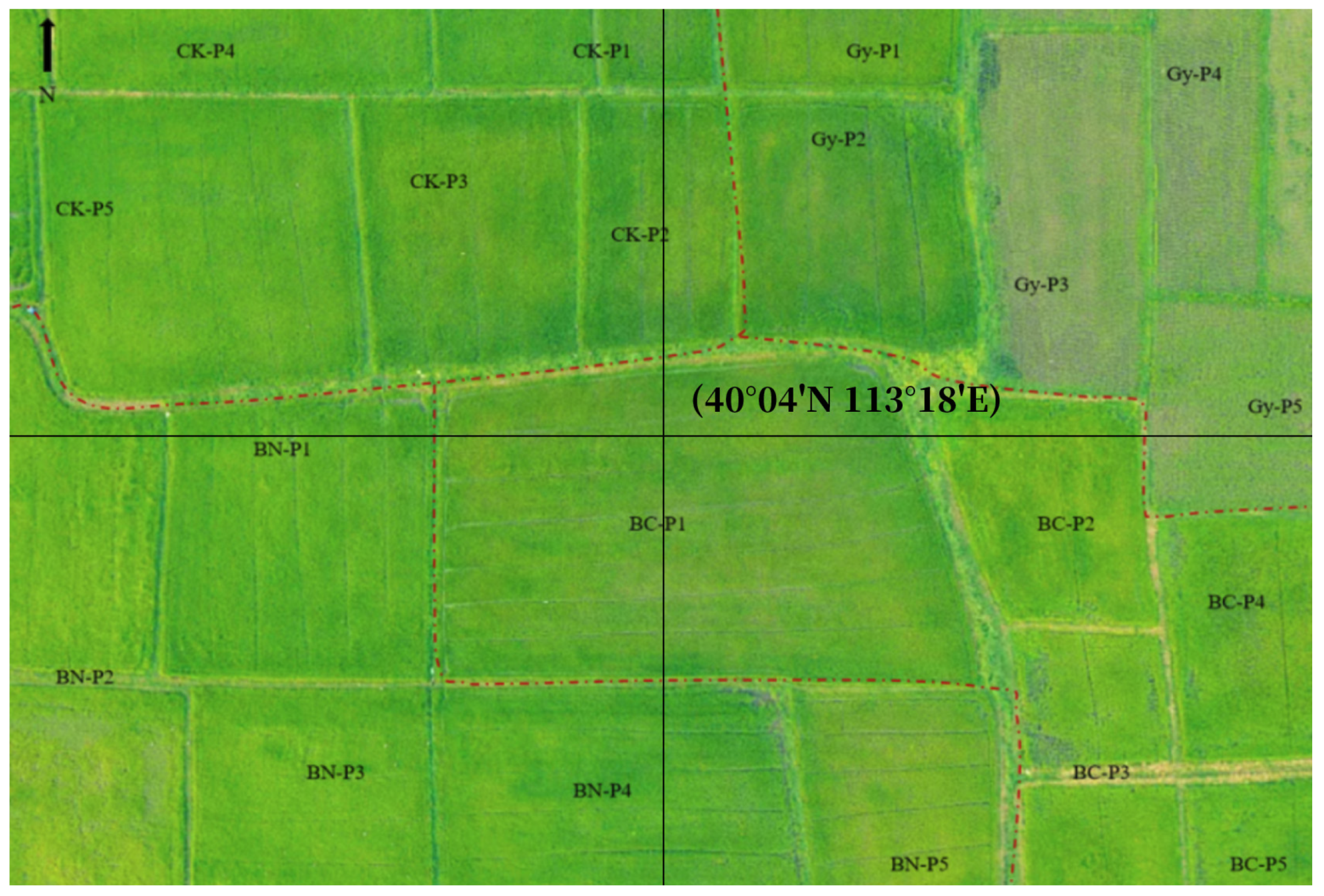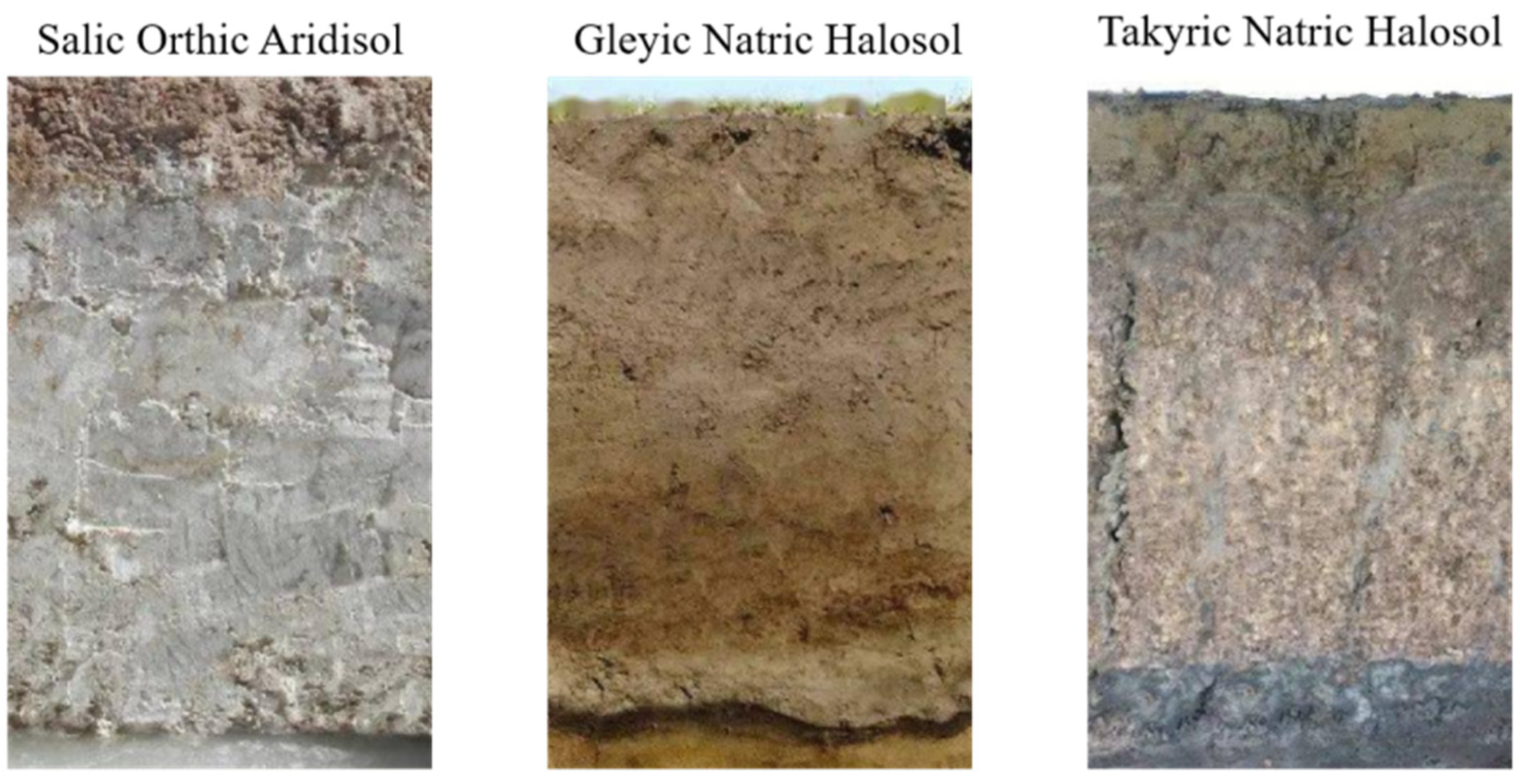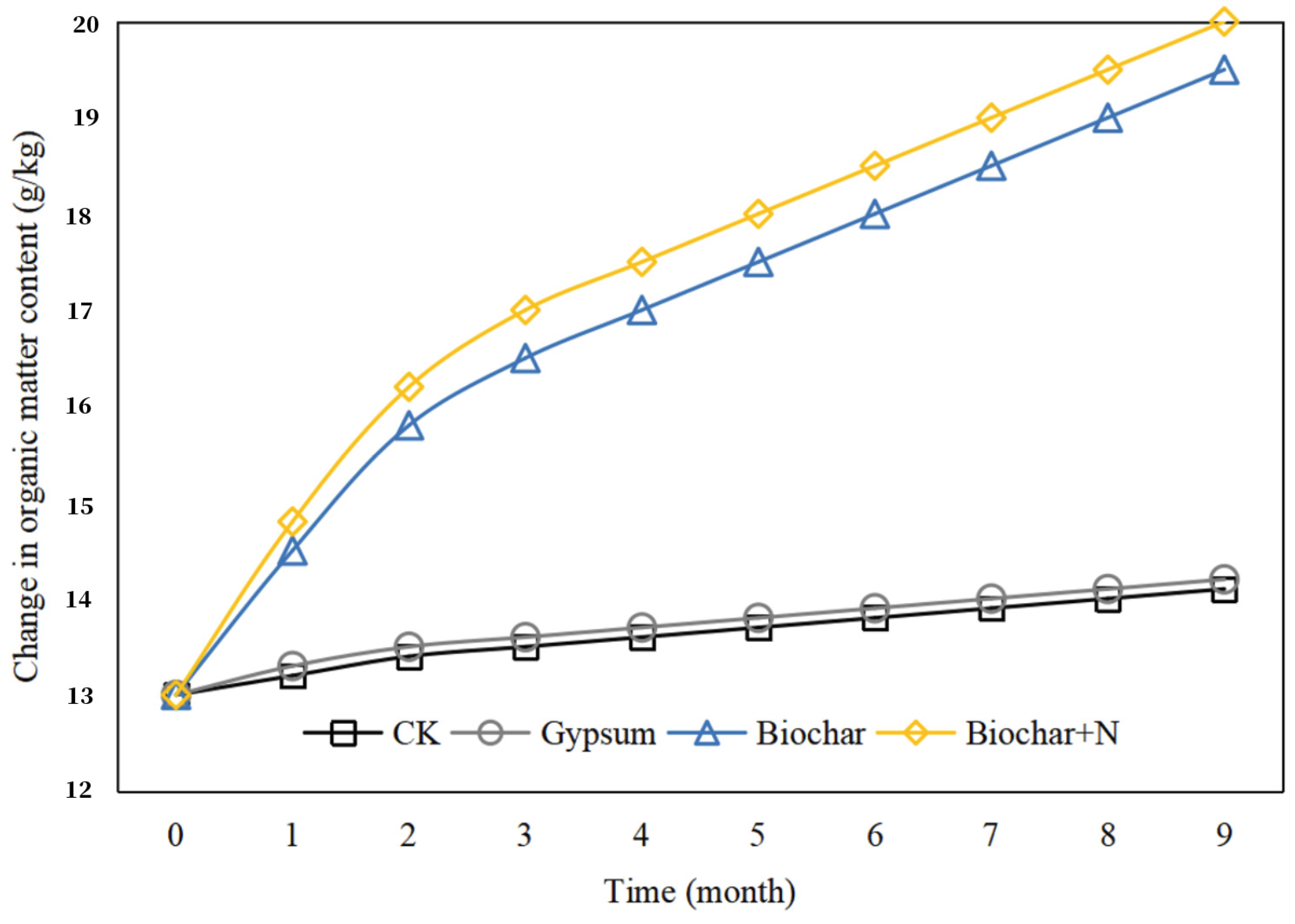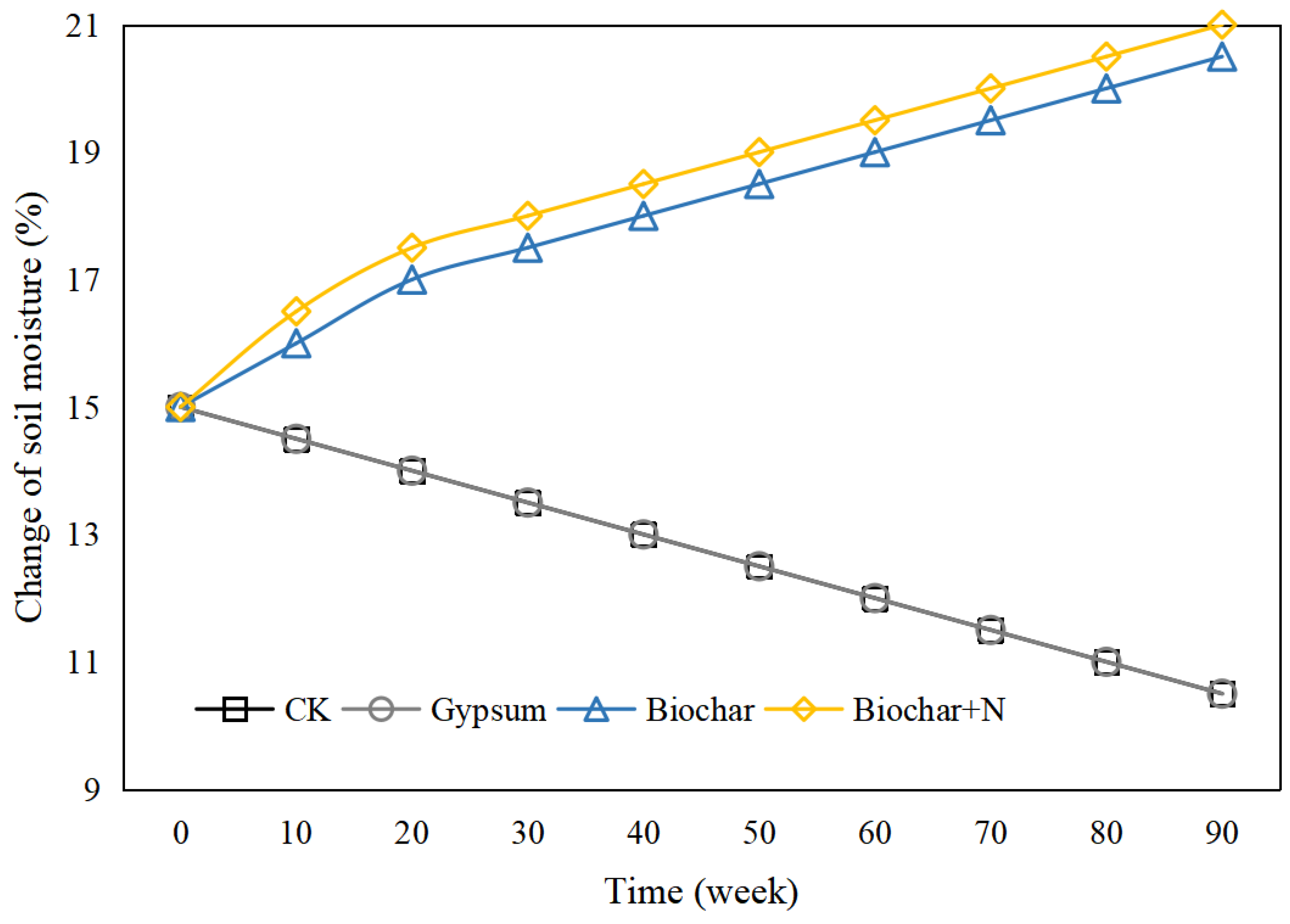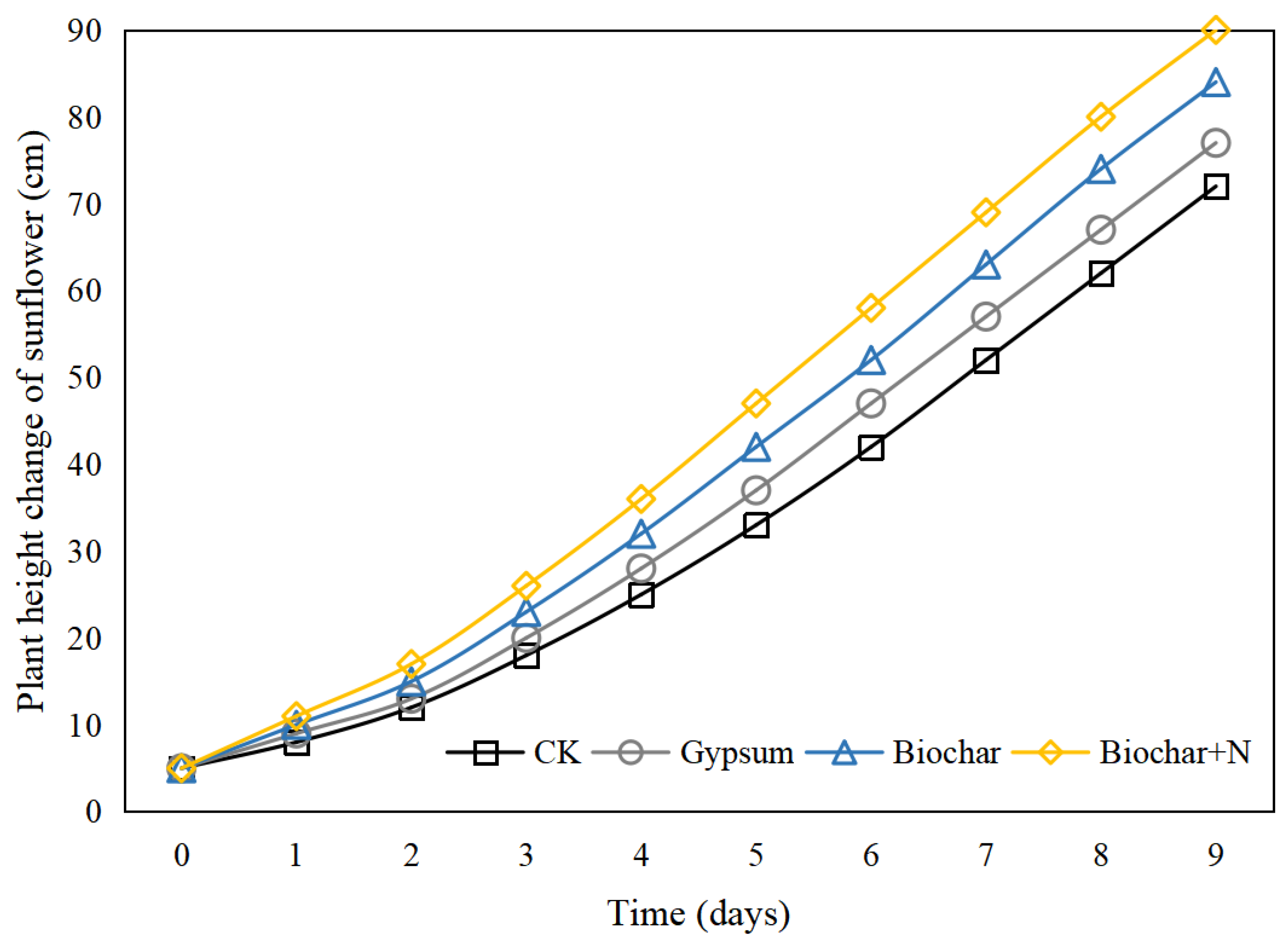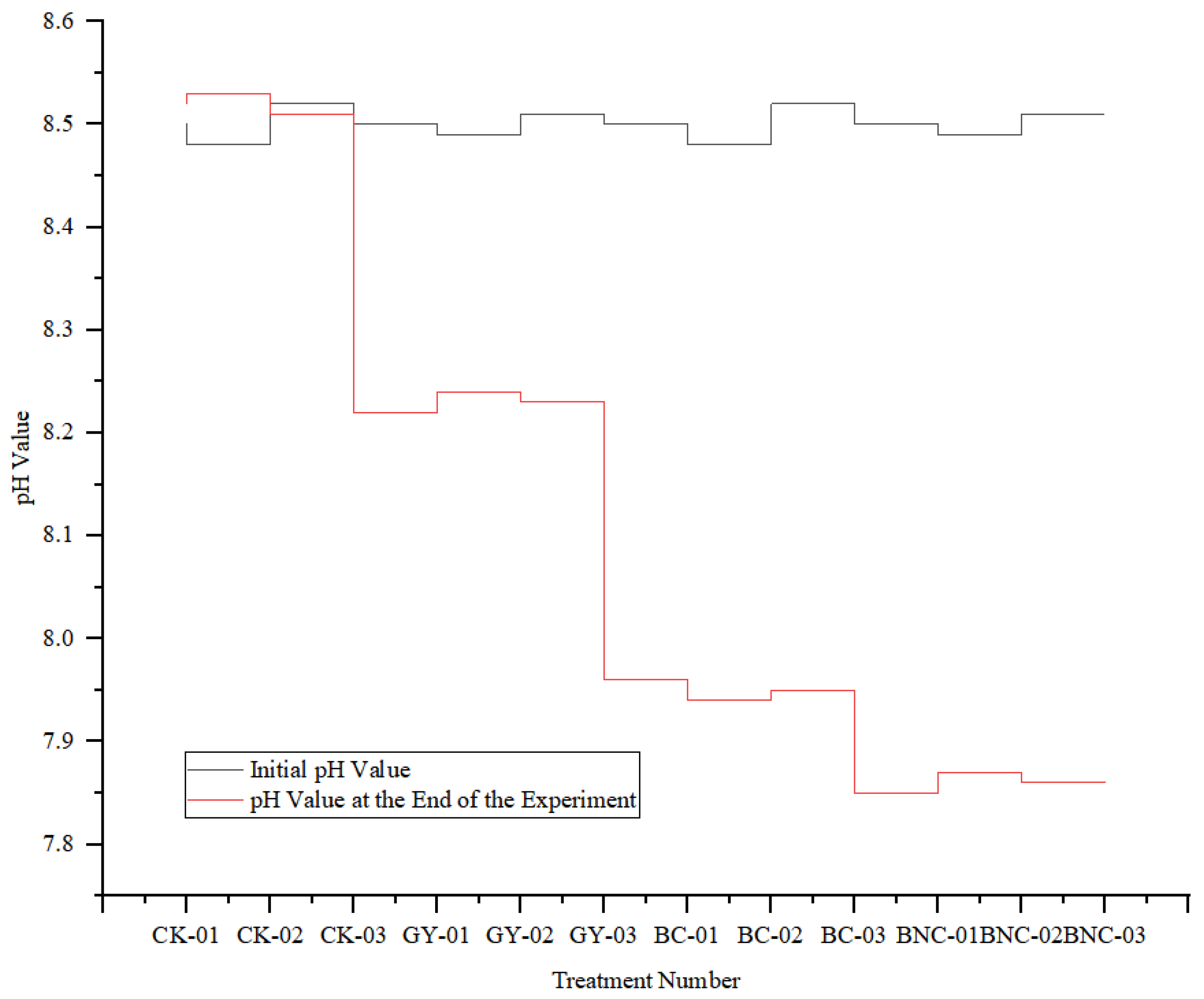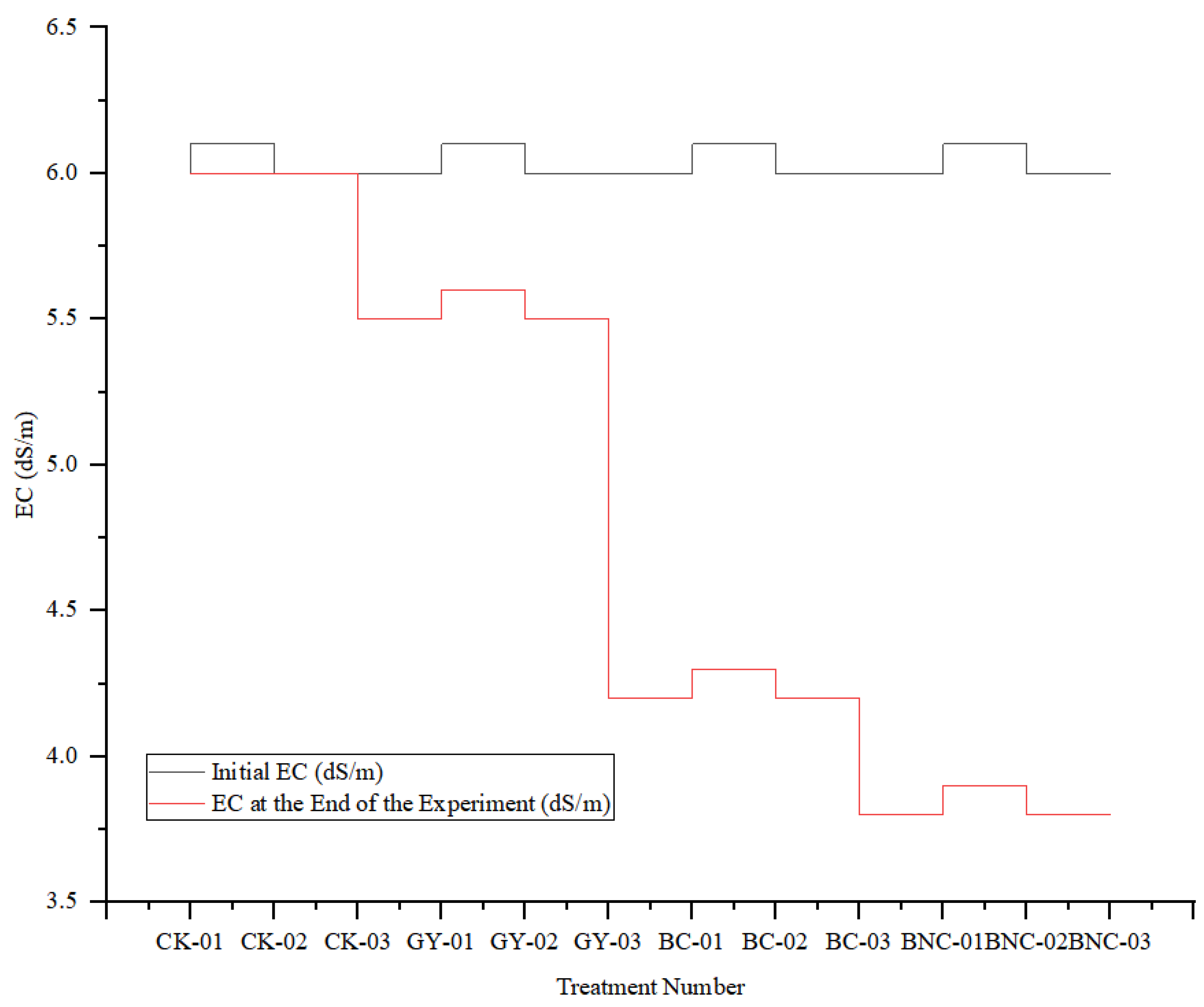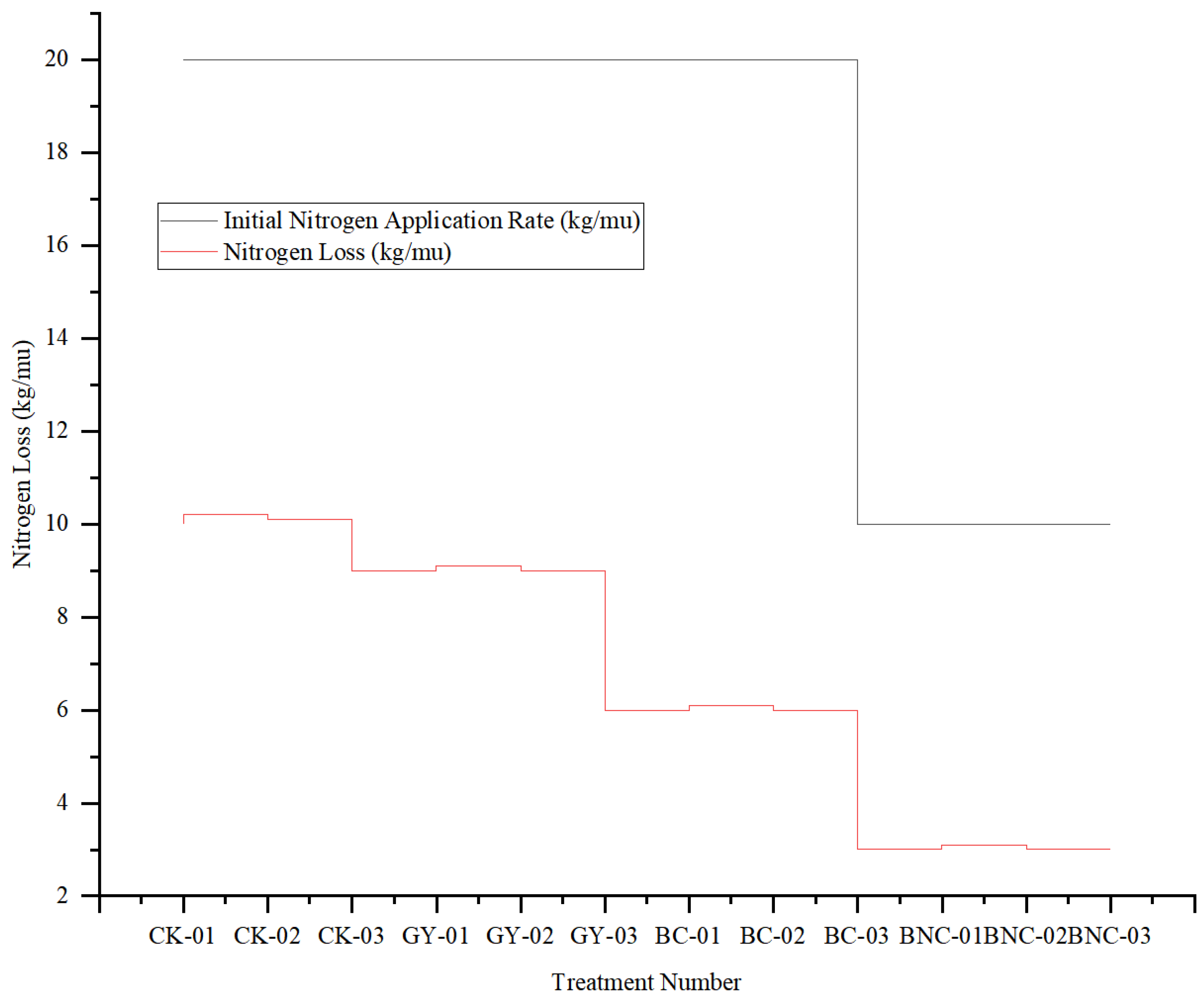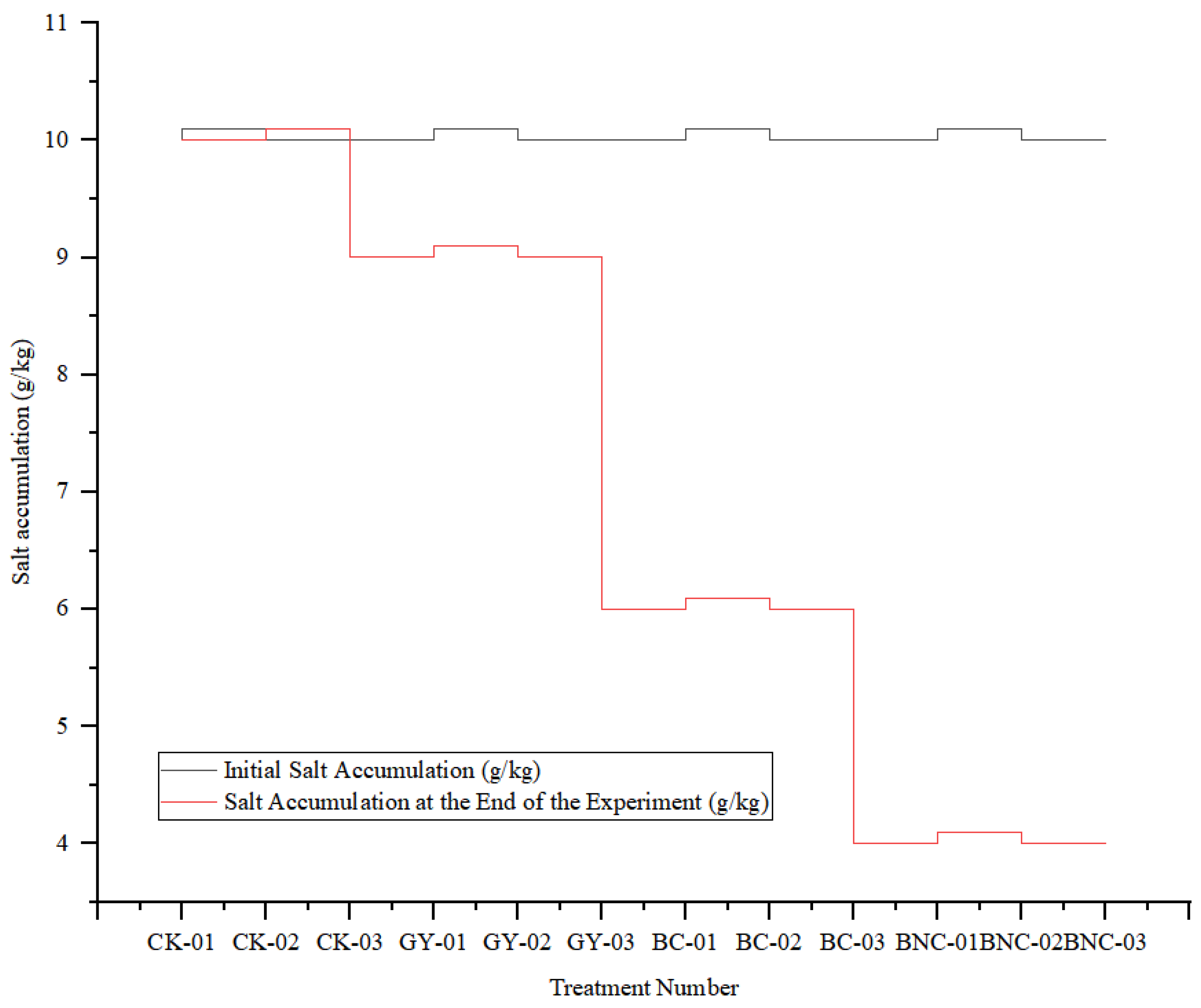1. Introduction
Against the backdrop of sustained global population growth and accelerated urbanization, agricultural production is facing unprecedented challenges [
1]. Especially under the dual pressures of water scarcity and soil quality degradation, how to achieve sustainable agricultural development has become a global focus of attention [
2]. Taking the Hetao irrigation district in northern China as an example, long-term irrigation activities have led to serious soil salinization problems, and excessive use of nitrogen fertilizers not only exacerbates environmental pollution but also causes great waste of resources [
3]. These issues not only threaten crop yield and quality but also pose severe challenges to regional ecological security. Water scarcity is one of the key factors restricting agricultural development [
4]. Globally, agricultural water accounts for up to 70% of freshwater resources, especially in arid and semi-arid regions where this proportion is more prominent [
5]. Unreasonable irrigation methods and excessive use of fertilizers further exacerbate soil degradation, especially soil salinization [
6]. Soil salinization is mainly caused by the accumulation of sodium ions, potassium ions, calcium ions, magnesium ions, chloride ions and sulfate ions [
7]. The presence of these ions changes the electrical conductivity of the soil, thereby affecting the water absorption capacity and nutrient absorption of plant roots. Therefore, it is particularly important to explore a method that can both save water resources and effectively improve saline soil [
8].
Nitrogen, as a key nutrient element for plant growth, plays a crucial role in agricultural production [
9]. However, excessive application of nitrogen fertilizer not only increases agricultural production costs but also triggers a series of environmental problems [
10]. Excessive nitrogen can lead to soil acidification, affecting the structure and function of soil microbial communities [
11]. At the same time, nitrate nitrogen can easily infiltrate groundwater with rainwater or irrigation water, causing pollution. In addition, nitrous oxide produced during the decomposition of nitrogen fertilizers is a powerful greenhouse gas that has a significant impact on global climate change [
12]. Therefore, how to maintain crop yield and quality while reducing nitrogen fertilizer application has become an important topic in current agricultural research [
13]. Biochar, as a solid product rich in carbon produced by biomass pyrolysis under anaerobic conditions, has shown great potential in soil improvement due to its unique physical and chemical properties [
14] The porous structure of biochar gives it significant water retention capacity, which can reduce the evaporation rate of soil moisture [
15]. Meanwhile, the functional groups on the surface of biochar can fix nutrient ions in the soil, reducing nutrient loss [
16]. In addition, biochar also has the function of regulating soil pH, promoting soil microbial activity and increasing soil enzyme activity, which helps accelerate the decomposition of organic matter and nutrient cycling. These characteristics make biochar an ideal material for improving saline soil, enhancing soil fertility and promoting crop growth [
17].
In the Hetao irrigation area, long-term high-intensity development and unreasonable agricultural practices have led to increasingly serious soil salinization problems. Excessive application of nitrogen fertilizer not only increases production costs but also exacerbates environmental pollution [
18]. Therefore, conducting research on saline soil improvement is of great significance for ensuring national food security, promoting ecological environment protection and achieving sustainable agricultural development goals [
19]. In recent years, although scholars at home and abroad have conducted extensive research on the causes and prevention measures of soil salinization, there is still relatively little research on how to improve soil under nitrogen fertilizer reduction conditions [
20]. The carbon nitrogen combined application group (Biochar + N) aims to explore whether the addition of biochar can promote crop growth and yield while reducing nitrogen fertilizer application. This can be obtained by comparing the crop growth and yield data of this treatment group with other treatment groups (especially the treatment group that only applies biochar and the control group) [
21].
The purpose of this study is to explore the application effect of different soil improvers in saline soil in Hetao irrigation area and their effects on sunflower growth through field experiments and numerical analysis. The research will focus on the following aspects: First, analyze the changes of soil pH, electrical conductivity (EC), organic matter content and other physical and chemical indicators before and after different amendments. Second, monitor and describe the spatial distribution of soil moisture, nutrients (especially nitrogen) and salt and their changing trends with time during the experimental period. Third, under the condition of nitrogen reduction, the effects of combined application of carbon and nitrogen on soil water conservation and salt inhibition, and the promotion of sunflower yield and water and nitrogen use efficiency were studied. Fourth, based on the above research results, a set of soil improvement and management models suitable for the actual situation of Hetao irrigation area is put forward, which can provide reference for other similar areas. To sum up, this study is helpful to deeply understand the mechanism of saline soil improvement and provide theoretical basis for formulating scientific and reasonable agricultural management strategies.
The contribution points of research innovation are as follows:
1. Through systematic field experiments, the study revealed for the first time the significant improvement effect of biochar treatment and carbon nitrogen composite treatment on soil physicochemical properties in the saline soil of Hetao irrigation district;
2. By comparing the growth and yield performance of sunflowers in different treatment groups, this study for the first time elucidated the significant promoting effect of carbon and nitrogen fertilization on crop growth and yield on saline soil;
3. On the basis of in-depth analysis on the improvement effect of biochar treatment and carbon nitrogen composite treatment on saline soil, combined with economic and environmental benefit analysis, a saline soil management and improvement strategy based on sustainable agricultural development goals is proposed.
2. Materials and Methods
In order to explore the application effect of different soil improvers in saline soil in the Hetao irrigation area, a series of field experiments were designed, and the effects of these improvers on soil physical and chemical properties, dynamic distribution of water, fertilizer and salt and crop growth and yield were assessed by numerical analysis.
2.1. Literature Review
It is necessary to review the research results in related fields when discussing soil management and improvement and protection strategies under the background of sustainable agricultural development. These studies reveal the current challenges and provide a variety of solutions and technical means.
With regard to the research on the impact of irrigation on regional water cycle, Liang et al. (2023) analyzed the impact of irrigation activities on water resources by coupling soil moisture assessment tools with MODFLOW model [
22]. The research shows that on the basis of reasonable planning of the irrigation system, the waste of water resources can be reduced to some extent and the problem of soil salinization can be alleviated. Chang et al. (2023) discussed the soil health status under different management modes and its influence on sustainable agricultural practices from the perspective of farming methods and crop rotation systems [
23]. Their research emphasized the importance of choosing suitable farming and rotation patterns for maintaining soil fertility and increasing crop yield. This has reference value for guiding the adjustment of planting structure in Hetao irrigation area. Zhao Jiang et al. (2024) summarized the application progress of microalgae in promoting crop growth and improving soil quality [
24]. Although the application of microalgae technology in actual agricultural production is still in the primary stage, it has great potential.
Li Linna (2023) expounded the concept of agricultural sustainable development and introduced several sustainable accounting practices [
25]. This study provides a framework for evaluating whether agricultural projects meet the sustainable development goals. In the southern mountainous area of China, Miao Jianqun et al. (2021) conducted a comprehensive assessment and empirical analysis of agricultural sustainable development [
26]. They pointed out that the special geographical conditions in mountainous areas require taking measures according to local conditions to achieve a win-win situation for ecological protection and economic development. Sun Zhilu et al. (2020) analyzed the development trend of food production in Africa and its development potential under the global sustainable development goal [
27]. Ding Mingjing et al. (2024) assessed the effects of different types of forest vegetation on soil quality based on the minimum data set [
28]. Their findings show that proper vegetation cover can not only improve soil structure but also enhance soil water-holding capacity.
Zhang Yanxu et al. (2020) studied the effect of inoculation with mycorrhizal fungi on alfalfa growth and soil improvement in the coal mine subsidence area [
29]. The results show that mycorrhizal fungi can significantly promote plant growth and improve soil properties. Yan Deren et al. (2020) pay attention to the effect of desert moss decomposition on soil improvement [
30]. Although the environmental conditions are quite different, their idea of improving soil quality by using microbial activities in natural ecosystems deserves further exploration. Huang Qiang (2022) developed a new type of soil conditioner, and its properties were deeply studied [
31]. These products are excellent at adjusting soil pH value, increasing soil aeration and water retention. Li et al. [
32] reviewed the research progress of soil amendments in the remediation of cadmium contaminated soil and the reduction of cadmium pollution risk in Chinese cabbage. It introduces the current situation, sources, and hazards of cadmium pollution in soil. As a common leafy vegetable, Chinese cabbage has a strong ability to accumulate cadmium. Chinese cabbage grown in cadmium contaminated soil is at risk of exceeding the limit of heavy metal cadmium, which can have adverse effects on human health. Biochar has a huge specific surface area and rich pore structure, which can effectively adsorb cadmium ions in soil. The oxygen-containing functional groups on its surface can undergo complexation reactions with cadmium ions, reducing the bioavailability of cadmium [
33]. Wang et al. [
34] elucidated the mechanism of soil improvement, analyzed its impact on soil physicochemical properties and crop growth and explored its application prospects. Huang et al. [
35] reviewed the research progress of AM fungi in soil remediation and improvement of abandoned ionic rare earth mines, elucidated their mechanisms for soil improvement, analyzed their effects on soil physicochemical properties, plant growth, and drought resistance, and explored their application prospects.
These studies cover many aspects, from macro-level water resources management to micro-level specific improvement measures, which laid a solid foundation for understanding the connotation of agricultural sustainable development and implementing effective soil management strategies. Future work should continue to pay attention to the combination of technological innovation and practical application to promote the development of agriculture in a more efficient direction.
2.2. Overview of Research Area
The experiment was conducted in Hetao irrigation district in the north of China. The region is located at about 40 degrees north latitude and 107 degrees east longitude and belongs to a typical temperate continental monsoon climate. The annual average temperature is about 8 °C, and the annual precipitation is between 250 and 350 mm, mainly in summer. Due to long-term dependence on the Yellow River water source for irrigation and large evaporation, soil salinization is widespread in the region. In this study, a farmland with an area of 5 hectares was selected as the experimental field. The plot is dominated by sandy loam, with high initial salt content, pH close to 8.5 and electrical conductivity (EC) above 6 dS/m, which is a typical saline soil environment. See
Figure 1 for the layout of soil sampling points in the experimental field. See
Figure 2 for the soil profile structure. This article studies the timely collection of soil samples after irrigation or rainfall to evaluate the impact of moisture changes on soil salinization and nutrient migration. When sampling, pay attention to recording the amount of irrigation, rainfall and the time after irrigation or rainfall. To evaluate the long-term effectiveness of soil improvement measures, a fixed time interval (once every quarter) is set for long-term monitoring and sampling. These sampling points should be consistent with the initial sampling points for comparison and analysis on the time series.
Due to the long-term dependence on the Yellow River water source for irrigation and high evaporation in the Hetao irrigation area, soil salinization is widespread. This indicates that the entire irrigation area may generally face the problem of soil salinization, but the specific degree of salinization, pH value and conductivity of each plot may vary. Therefore, these parameters (high initial salt content, pH value close to 8.5, conductivity higher than 6 dS/m) describe the characteristics of specific plots in the experimental field, rather than the average level of the entire study area. If we want to understand the soil salinization situation in the entire Hetao irrigation area, more extensive sampling and analysis are needed.
2.3. Experiment Design
The preparation of biochar in this article involves high-temperature pyrolysis of biomass such as crop waste and animal manure under anaerobic or low oxygen conditions. This process produces biochar, bio-oil, and biogas. Biochar has various agricultural and environmental applications due to its porous structure and rich surface functional groups. The experimental period of this study is set to one year, starting from spring 2023 and ending in the following spring, to ensure comprehensive observation and evaluation of the effects of different treatment groups on soil properties, crop growth, and yield. Starting from the fourth month, regularly monitor the growth of plants, including recording parameters such as plant height, leaf number and leaf area index. Collect soil and plant samples for analysis during critical growth periods such as sowing, growth, flowering and fruiting. Soil sample analysis includes the determination of physical and chemical indicators such as pH value, conductivity, organic matter content, total nitrogen, available phosphorus, available potassium, as well as the measurement of heavy metal concentration. In this study, four processing groups were set up, each of which was repeated three times to ensure the reliability and repeatability of the data:
(1) Control group (CK): routine management was maintained without adding any improver;
(2) Gypsum treatment group (Gypsum powder): 500 kg gypsum powder was applied per mu, aiming at reducing soil alkalinity by replacing sodium ions with calcium ions;
(3) Biochar treatment group: 2 tons of biochar was applied per mu, and its porous structure was used to improve soil water-holding capacity and adsorption capacity of harmful substances;
(4) Combined application of carbon and nitrogen (Biochar + N): based on biochar, the amount of nitrogen fertilizer was reduced by 50%, and the effect of biochar under nitrogen reduction was explored.
To ensure the reliability and repeatability of the data, four treatment groups were set up in this study, and each treatment group was replicated three times (see
Table 1 for details). Specifically, the control group (CK) had three replicates (CK-01, CK-02 and CK-03, respectively); the gypsum treatment group (Gypsum) also had three replicates (GY-01, GY-02 and GY-03); the biochar treatment group (Biochar) had three replicates, namely BC-01, BC-02 and BC-03; and the biochar combined with nitrogen treatment group (Biochar + N) also had three replicates, which were BNC-01, BNC-02 and BNC-03. Each treatment was uniformly managed in accordance with local agricultural operation procedures.
At the start and end of the experiment, soil samples were collected, respectively, and basic physical and chemical indexes such as pH value, electrical conductivity (EC) and organic matter content of soil were determined by standard methods. As for the contents of total nitrogen, available phosphorus, available potassium and other nutrients, Kjeldahl method, Olsen-P extraction method and NH4OAc extraction method are used to determine them. In addition, atomic absorption spectrometry (AAS) was used to measure the concentration of heavy metals in soil. For plant samples, plant height, leaf number, leaf area index and other growth parameters will be recorded regularly, and the yield will be counted at harvest time. Grain quality analysis covers protein content and oil content, and these parameters are determined by near infrared spectroscopy (NIRS). The nitrogen use efficiency in crops is evaluated by calculating the total nitrogen content in dry matter above ground.
3. Result Analysis
In this study, field experiments were carried out in different treatment groups to assess the improvement effect of soil improver on saline soil in Hetao irrigation area and its influence on sunflower growth and yield.
3.1. Changes of Soil Properties and Treatment Effect
Soil samples were collected at the start and at the end of the experiment, and the basic physical and chemical indexes such as pH value, electrical conductivity (EC) and organic matter content were determined. In addition, the changes of total nitrogen, available phosphorus, available potassium and other nutrients in the soil were measured. The results showed that biochar treatment significantly reduced soil pH value and increased soil organic matter content.
Figure 3 shows the change of soil pH value under different treatment groups.
Figure 4 shows the changes of soil organic matter content under different treatment groups. Gypsum treatment also showed a certain improvement effect, but its improvement extent was not as obvious as that of biochar treatment.
In order to know the changes in soil moisture, nutrients and salinity in real time, soil moisture sensors and conductivity sensors were installed in each treatment area. With the continuous monitoring of data, it is found that biochar treatment can effectively maintain soil moisture and reduce water evaporation loss.
Figure 5 shows the changing trend in soil moisture during the test period. Combined application of carbon and nitrogen maintained high soil moisture and inhibited salt accumulation to some extent.
3.2. Crop Growth and Yield Statistics
During the growing season, the plant height, leaf number, leaf area index and other growth parameters of sunflower were recorded regularly, and the yield was counted at the harvest time. The results showed that the plant height of sunflower under the combined application of carbon and nitrogen increased the fastest, and the final yield was significantly higher than other treatment groups.
Figure 6 shows the changes of sunflower plant height with time under different treatment groups.
Table 2 shows the comparison of sunflower yield under different treatment groups. This shows that while properly reducing the amount of nitrogen fertilizer, the use of biochar can effectively promote crop growth and increase yield. Focusing on the changes in soil properties and treatment effects are very valuable. Collecting water samples may indeed provide additional validation for research results. The nutrient content in water samples (such as nitrogen, phosphorus, potassium, etc.) can reflect the migration of soil nutrients. If the content of available phosphorus and available potassium in the soil increases, the nutrient content in the water sample also reflects it. Water sample data helps to understand the water flow and exchange processes in the hydrological cycle, which is of great significance for understanding soil moisture retention and reducing water evaporation losses.
3.3. Assessment of Water and Nitrogen Use Efficiency
In order to further assess the actual effect of each treatment group, the water and nitrogen use efficiency was calculated. The results showed that the water and nitrogen use efficiency in the treatment group with the combined application of carbon and nitrogen was the highest, which was more than 1.5 times that of the control group (
Table 3). This means that by optimizing fertilization strategies, resources can be saved, and agricultural production benefits can be improved to some extent.
3.4. Analysis of Experimental Treatment Group Properties
After a season of field experiments, it was found that different treatment groups had significant effects on soil physical and chemical properties (see
Table 4 and
Figure 7). At the end of the experiment, the soil pH value of the control group (CK) was 8.52, while that of the Gypsum treatment group (Gypsum) was reduced to 8.23, which showed a certain acid–base regulation. The pH values of Biochar treatment group (biochar) and carbon–nitrogen combined treatment group (Biochar + N) decreased to 7.95 and 7.86, respectively, indicating that biochar has obvious advantages in regulating soil pH value.
Electrical conductivity (EC) is an important index to measure soil salt content. The results showed that the EC values of biochar treatment group and carbon–nitrogen combined treatment group were 4.2 dS/m and 3.8 dS/m, respectively, which were significantly lower than the control group’s 6.0 dS/m (see
Table 5 and
Figure 8). This shows that biochar can effectively inhibit salt accumulation and improve the soil environment.
Further analysis of the change in organic matter content showed that the soil organic matter content in the control group had almost no change, while the organic matter content in the biochar treatment group and the carbon–nitrogen combined treatment group increased by 0.6% and 0.7%, respectively. This is closely related to the characteristic that biochar is rich in carbon, as shown in
Table 6 and
Figure 9.
The contents of nutrients such as total nitrogen, available phosphorus and available potassium also increased, especially in the treatment group of the combined application of carbon and nitrogen, which reached the highest level. The results show that the rational application of biochar can not only improve soil fertility but also optimize the nutrient supply structure to some extent.
3.5. Nutrient Dynamics Under Water Management
In terms of water management, the soil water content of biochar treatment group and the carbon–nitrogen combined treatment group has consistently remained at a high level (especially in dry season, its water retention ability is particularly prominent). In contrast, the soil water content in the control group and gypsum treatment group fluctuated greatly, especially during the high temperature in summer, the evaporation rate of water accelerated, which led to the obvious decline of soil moisture. The study strictly controlled the application amount of gypsum to avoid the negative effects caused by excessive use. Secondly, monitoring of gypsum sources should be strengthened to ensure that they do not contain harmful substances and prevent pollution to soil and groundwater. At the same time, we should actively explore safer and more environmentally friendly soil amendments, such as biochar, to replace or supplement the use of gypsum.
For nutrient dynamics, the treatment group with combined application of carbon and nitrogen showed the best nutrient conservation effect. As shown in
Table 7 and
Figure 10, the nitrogen loss of this treatment group is the lowest, only about one-third of that of the control group. Therefore, it can be considered that the combination of biochar and reduced nitrogen fertilizer can reduce nitrogen volatilization and leaching and improve nitrogen utilization efficiency. The availability of phosphorus and potassium was also enhanced in the combined application of carbon and nitrogen. This may be because biochar improves the soil structure and promotes the absorption of nutrients by roots.
Salt regulation is one of the focuses of this study. The results in
Table 8 and
Figure 11 show that the soil salt accumulation in the combined application of carbon and nitrogen is the least, with an average reduction of about 40%, which is far superior to other treatment groups.
Table 8 shows the comparative results of soil salt accumulation in different treatment groups.
This result verifies the hypothesis that biochar can not only adsorb harmful substances but also inhibit the rise of salt by adjusting the soil microenvironment.
3.6. Differences in Sunflower Growth Under Different Treatment Conditions
Sunflower, as the main crop, shows obvious growth differences under different treatment conditions. According to the data recorded regularly, the sunflower plant height in the combined application of carbon and nitrogen has the fastest growth rate, the largest number of leaves and the largest leaf area index, and the overall growth potential is stronger than other treatment groups. At the final harvest, the sunflower yield of the treatment group with combined application of carbon and nitrogen reached 350 kg per mu, which was about 30% higher than that of the control group, and the grain plumpness was good and the quality was excellent (see
Table 9 and
Figure 12).
Through the calculation of water and nitrogen use efficiency of each treatment group, it was found that the water and nitrogen use efficiency of the treatment group with the combined application of carbon and nitrogen was the highest, which was more than 1.5 times that of the control group. This means that while reducing the amount of nitrogen fertilizer, using scientific and reasonable fertilization strategies can save resources and improve agricultural production efficiency.
4. Discussion
In this study, the improvement effects of different soil improvers on saline soil in Hetao irrigation area and their effects on sunflower growth and yield were discussed. The results showed that the combination of biochar and reduced nitrogen fertilizer showed significant advantages in improving the physical and chemical properties of the soil, regulating the dynamic balance of water-nutrient-salt and promoting crop growth.
4.1. Changes in Physical and Chemical Properties of the Soil
In this study, both the biochar treatment group and the combined application of carbon and nitrogen treatment group showed the effect of significantly reducing soil pH value. This is mainly due to the fact that biochar is rich in organic matter, which can neutralize hydrogen ions (H) in soil, thus reducing the pH value. Biochar also has good adsorption performance, which can fix sodium ions (Na) in soil and reduce its damage to soil structure, thus reducing soil conductivity. In contrast, although gypsum treatment also showed certain improvement effects, its improvement range was not as good as that of biochar treatment group.
In addition to adjusting pH and conductivity, biochar can significantly increase the content of soil organic matter. This is because biochar itself is rich in carbon, and its porous structure provides a habitat for microorganisms and promotes the decomposition and transformation of organic matter. With the increase in organic matter content, the contents of total nitrogen, available phosphorus and available potassium in soil also increase. This shows that the reasonable application of biochar can not only improve soil fertility but also optimize nutrient supply structure.
4.2. Dynamic Distribution Characteristics of Water-Nutrient-Salt
The unique structure of biochar makes it have excellent water retention capacity. In the dry season, the soil water content of biochar treatment group and carbon–nitrogen combined treatment group consistently remained at a high level, and its water retention effect was particularly significant. The porous structure of biochar increases soil water holding capacity and reduces water evaporation loss. A reasonable irrigation system combined with the application of biochar can further improve water use efficiency and reduce water waste.
The treatment group with combined application of carbon and nitrogen performed well in nutrient conservation, and the nitrogen loss was only about one-third of that of the control group. This shows that the combination of biochar and reduced nitrogen fertilizer can effectively reduce nitrogen volatilization and leaching and improve nitrogen utilization efficiency. In addition, the availability of phosphorus and potassium was also significantly enhanced in the combined application of carbon and nitrogen. This may be because biochar improves the soil structure and promotes the absorption of nutrients by roots. In actual production, we should pay attention to scientific fertilization strategy and realize the maximum utilization of resources through reasonable collocation of biochar and nitrogen fertilizer.
Salt regulation is one of the focuses of this study. The results showed that the soil salt accumulation in the treatment group with the combined application of carbon and nitrogen was the least, with an average decrease of about 40%. This result verifies the hypothesis that biochar can not only adsorb harmful substances but also inhibit the rise of salt by regulating the soil microenvironment. With the help of reasonable drainage measures, it is also necessary to remove excess salt in the soil in time and maintain the balance of soil salt.
4.3. Sunflower Growth Status and Yield Response
Sunflowers, as the main crop, exhibit significant growth differences under different treatment conditions. The sunflower plant height growth rate was the fastest, the number of leaves was the highest, the leaf area index was the largest and the overall growth potential was stronger in the group treated with carbon and nitrogen. This indicates that the combination of biochar and reduced nitrogen fertilizer can not only improve the soil environment but also promote crop growth and development. Through the measurement of photosynthesis related parameters, it was found that the net photosynthetic rate and stomatal conductance of the carbon and nitrogen combined treatment group were significantly higher than those of the control group. These results indicate that the treatment is beneficial for improving the photosynthetic efficiency of crops, thereby promoting dry matter accumulation.
At the final harvest, the sunflower yield of the carbon and nitrogen combined treatment group was higher than that of the control group, and the grain plumpness was good with excellent quality. This indicates that through scientifically reasonable fertilization strategies, resources can be saved, and agricultural production efficiency can be improved. Through analysis of grain composition, it was found that the protein and oil content of the carbon and nitrogen combined treatment group were both increased, further proving that this method can improve crop yield and product quality.
From the perspective of economic benefits, although the carbon and nitrogen combined application treatment group may have slightly higher initial inputs than traditional fertilization methods, it still has a high economic return rate in the long run due to its significant improvement in crop yield and quality. By reducing the amount of nitrogen fertilizer used, production costs have been lowered, and environmental pollution risks have been reduced. This strategy achieves a win-win situation between economic benefits and environmental protection. Given the significant advantages of the carbon and nitrogen composite treatment group in promoting sunflower growth, improving yield and quality, it is recommended to widely apply this technology in agricultural production. By combining biochar and reducing nitrogen fertilizer usage, not only can resources be saved, but environmental pollution risks can also be reduced. There should be development of customized fertilization plans based on soil types, climate conditions, and crop types in different regions. By precise fertilization, unnecessary nutrient inputs can be reduced, fertilizer utilization efficiency can be improved and the negative impact of nutrient loss on the environment can be minimized. In addition to reasonable fertilization strategies, soil health management should also be strengthened, including improving soil structure, increasing soil organic matter content and maintaining soil moisture balance. These measures help enhance soil fertility and ecological functions, providing favorable environmental conditions for crop growth.
Under the current global climate change background, the sustainability of agricultural production has received widespread attention. Research has shown that the rational use of biochar can not only improve soil quality but also reduce greenhouse gas emissions and alleviate the pressure of climate change. Biochar plays an important role in carbon sequestration by adsorbing and fixing greenhouse gases such as carbon dioxide (CO2), methane (CH4) and nitrous oxide (N2O) in soil. By improving nitrogen utilization efficiency, the N2O emissions generated during nitrogen fertilizer application have been reduced, further reducing the negative impact of agricultural production on the environment.
4.4. Technology Popularization and Application Prospect
In view of the good results achieved in this study, it is suggested that the technical model of combining biochar with reduced nitrogen fertilizer should be popularized in similar areas with fragile ecological environment. First of all, with the guidance and support of the government, demonstration fields can be established to show the practical application effect of new technologies. Secondly, there needs to be strengthening of technology research and development, and optimization of the formula and application amount of biochar according to soil conditions and crop needs in different regions. Finally, carrying out of the training and technical guidance to help farmers master the correct fertilization methods needs to take place.
To sum up, through systematic field experiments, this study discussed the application effects of different soil improvers in saline soil in Hetao irrigation area, which provided strong support for solving the problem of soil salinization in local and even wider areas. Future research will further optimize the combined application scheme of carbon and nitrogen, explore more soil improvement measures suitable for different ecological conditions and promote the sustainable development of agriculture.
Optimizing the formula and application amount of biochar based on soil conditions and crop demands in different regions is the key to achieving technological promotion. Therefore, it is recommended to strengthen technological research and development, determine the optimal biochar ratio and fertilization plan through scientific experiments and data analysis, in order to adapt to different ecological conditions. The porous structure of biochar and the application of reduced nitrogen fertilizer can help improve soil structure, enhance soil fertility and water retention capacity. In the long run, this will help improve soil quality, enhance soil resistance to salinization and provide a more suitable environment for crop growth. The combination of biochar and reduced nitrogen fertilizer can significantly improve crop yield and quality, while reducing fertilizer application and lowering agricultural production costs. This not only helps to ensure food security, but also promotes sustainable agricultural development, achieving a coordinated and unified economic, social, and ecological benefit.
5. Conclusions
The Hetao irrigation district is facing serious soil salinization problems. This study evaluated the improvement effect of different soil amendments on saline soil and their impact on sunflower growth and yield through field experiments. In terms of the physical and chemical properties of soil, the biochar treatment group and the carbon nitrogen composite treatment group significantly reduced soil pH and conductivity, effectively inhibited soil salt accumulation, and increased soil organic matter and nutrient content. The porous structure of biochar enhances soil water retention capacity and reduces water evaporation. The combined application of carbon and nitrogen also reduces nitrogen loss and prevents salt from moving to the soil surface. In terms of crop growth and yield, the group treated with the carbon and nitrogen combined application had the best sunflower growth, with higher plant height, leaf number, and leaf area index than other treatment groups, and a yield about 30% higher than the control group.
In addition, the net photosynthetic rate and stomatal conductance of the treatment group were significantly higher than those of the control group. From the perspective of economic and environmental benefits, although the initial investment of the carbon and nitrogen combined application is slightly higher, the long-term economic return rate is high, and it can reduce production costs and environmental pollution risks. Therefore, it is recommended to promote the technology model of combining biochar with reduced nitrogen fertilizer in fragile areas with similar ecological environments, and to help farmers master the correct fertilization methods through demonstration fields, technology research and development and training guidance.
This study demonstrates the effectiveness of combining biochar with reduced nitrogen fertilizer, providing technical support and theoretical basis for soil salinization in the Hetao irrigation area and wider regions, and helping to promote the development of green agriculture and achieve sustainable agricultural development goals.
